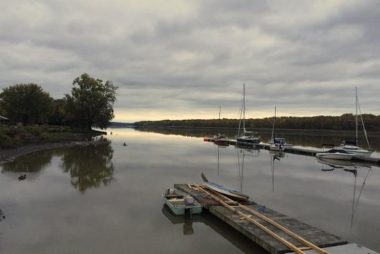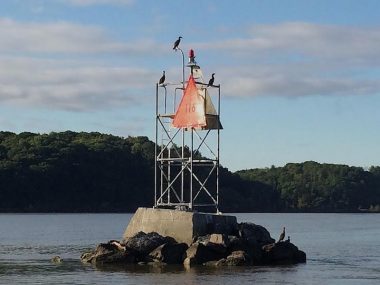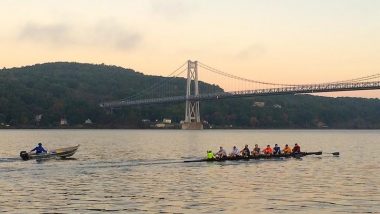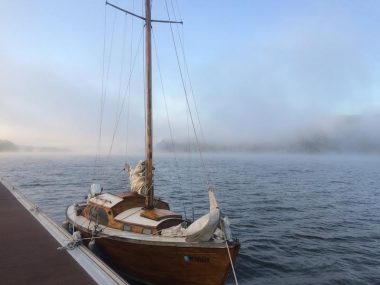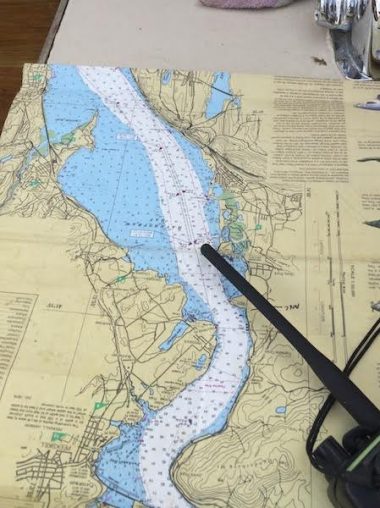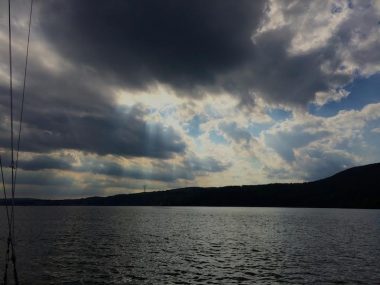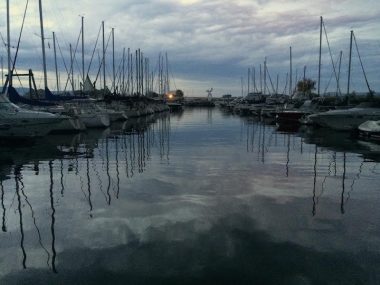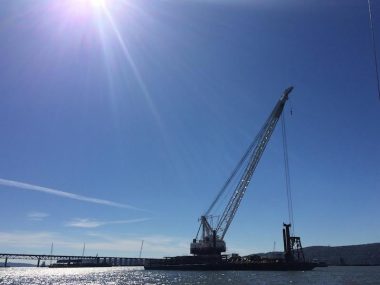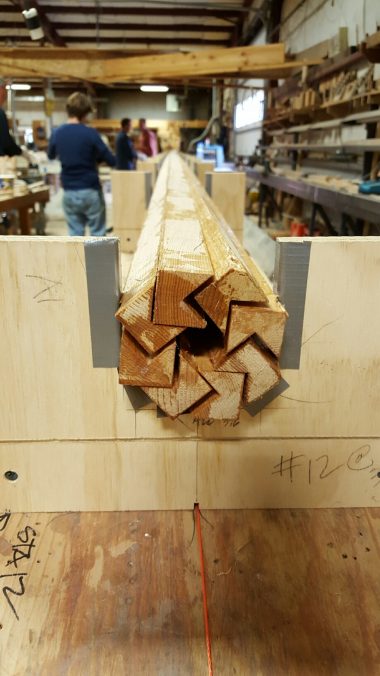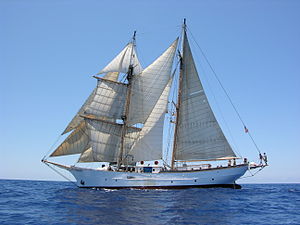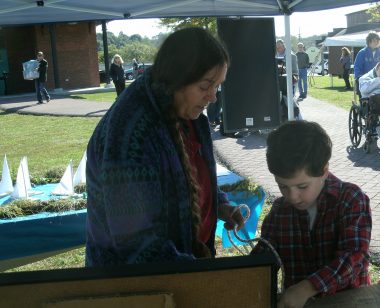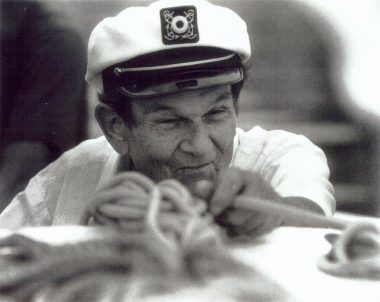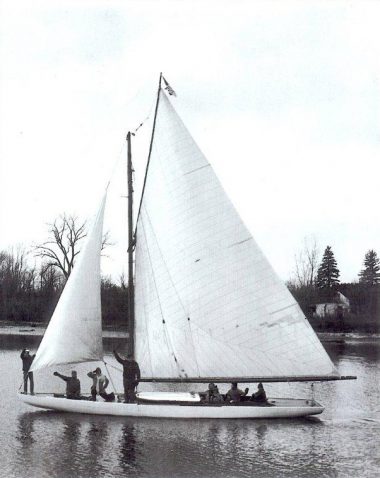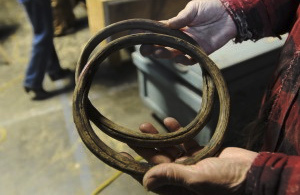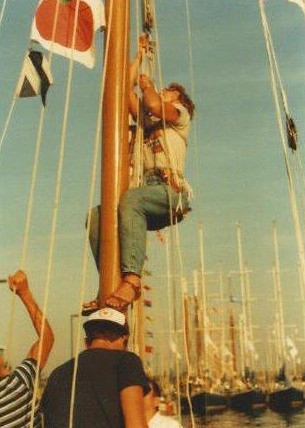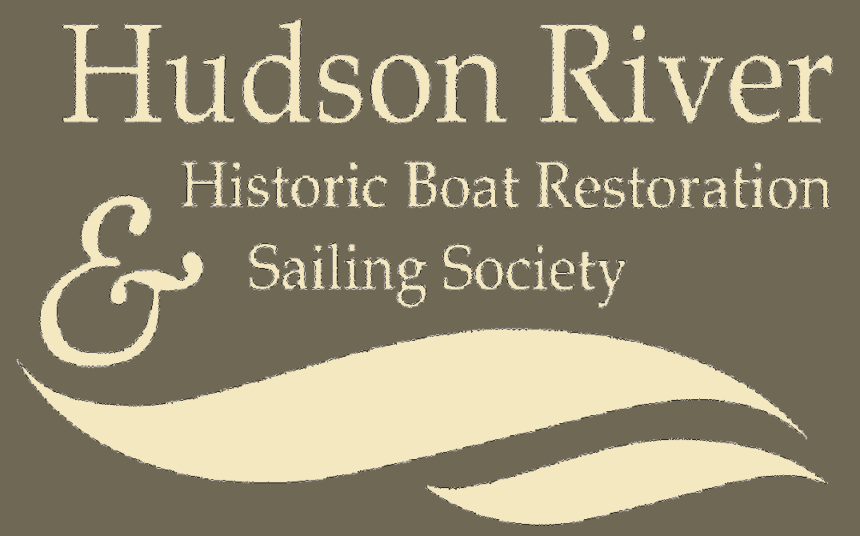Eleanor’s B/log
Share your stories about sailing on the Hudson and boat restoration by contacting us at info@hudsonriverhistoricboat.org and mark them for The B/log. We also welcome comments and questions.
Solo Trip down the Hudson
Saturday, October 31, 2015
Artie Christie, a member of Hudson River Historic Boat, recently sailed his Quest from Athens to the Tappan Zee Bridge and back to Hideaway Marina in Kingston, where she will winter. The Quest, named by her previous owner, is a Dutch Treat, a 25′ hard-chined mahogany-on-oak sloop with a draft of 4’11” and a beam +- 7′. She was built in Holland in 1954.
On the return trip Artie spent two days at a Beacon boat club dock where Greg Grann, “a great guy,” helped with the outboard.
It was hard picking the photos to include in the post.
Our Mast
Saturday, October 24, 2015
Suzanne Leahy, Spar Builder at the Beetle Boat Company in Wareham, Mass. and her crew have been taking the work of building the mast for the sailboat Eleanor very seriously. The Hudson River Historic Boat Restoration & Sailing Society contracted with the Beetle Boat Company last summer to build the 35’3″ mast, the 25′ boom and the 14′ gaff. The light weight mast is built using staves cut from Sitka Spruce from the north western part of the United States. Suzanne says that the spruce stock is some of the best/clearest she has ever seen. The photo shows the staves in the birds mouth technique of spar building before they are clamped. The mast will be loaded onto a 40′ lathe which will shape the mast into its final round shape.
The goal of $18,000.00, the cost to build the three spars, was achieved through sales of souvenir hand crafted wooden Eleanor ornaments, tee shirts, contributions from members and friends, and fund raisers; the most recent one, The Great Lawn and Grand Porch Party held in May at Rokeby, Barrytown. The next major fund raising effort will be for the sails which are being custom made for the 1903 Clinton Crane sailboat by Nat Wilson, in East Boothbay, Maine. To insure that all parts of the rig are in balance it was necessary for Wilson and Leahy to collaborate on the sail and spar plan.
The desire to learn how to sail
Sunday, August 9, 2015
One important goal of Hudson River Historic Boat’s mission, often overlooked when we are talking about ourselves during this period of intense focus on reconstruction of Eleanor, is to “serve as a resource for the general public who . . . desire to learn how to sail.
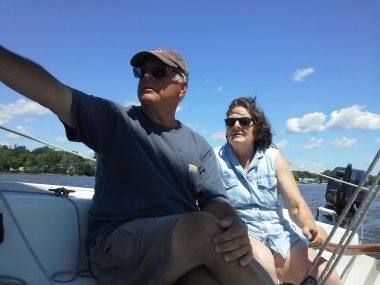 Member Pete Tenerowicz on a teaching sail with Hudson resident Kathy Hamm Parchuck
Member Pete Tenerowicz on a teaching sail with Hudson resident Kathy Hamm Parchuck
Today there is an article in the New York Times by Maya Jasanoff who is writing a book on Joseph Conrad.
Before Conrad published his first novel in 1895, he spent 20 years working as
a merchant sailor, mostly on sailing ships, and fully half his writing — including
“Heart of Darkness,” “Lord Jim” and “The Secret Sharer” — deals with sailors,
ships and the sea. These loom so large for him that as I have researched a book
about Conrad’s life and times, I have felt it essential to travel by sea myself.
And she did. Maya “hitched” a ride on the 134 foot brigantine Corwith Cramer, a classroom on the sea for students at Sea Education Association, who for over 40 years has offered field-based environmental education through its accredited study abroad program with Boston University. As a bonus the students learn to sail.
She spent time with “a row of pallid sailors crouched at the leeward rail.” The 12 students who were on board with Maya were learning the
grueling schedule of round-the-clock watch duty, hauling and heaving lines,
setting and striking sails, scrubbing dishes and floors. They were learning the
ropes just as Conrad did, 140 years ago.
It’s hard to think of a less relevant skill in today’s job market than knowing your
jib halyard from your main sheet.
But by the end of her sea journey and the end of her Opinion piece in the paper Maya knows her arduous journey from Cork to Brittany was well worth those uncomfortable, unpleasant moments, and was much more relevant to our present day life than she ever imagined.
I disembarked from the Corwith Cramer knowing things I had not appreciated
otherwise. I learned that to stay on course at the helm you have to watch the
horizon more than the compass. I learned that sails balance a ship, so much
so that oceangoing steamships carried rigs for stability long after they used
them for auxiliary power. I learned how to steady myself by swinging like the
gimbaled tables in the saloon, which seesawed wildly with the ship’s roll while
plates and glasses didn’t budge.
She gained new insight into Conrad, progress and obsolescence, and of the value and art and ethics of sailing. But she says it so well that reading her article in full is a must.
We at HRHB aren’t taking to the the oceans in tall ships with novice seamen and seawomen, but we do have our own education program. Volunteer craftsmen meet every Thursday night where they share skills on shipbuilding, restoration, woodworking and the physics of sail.
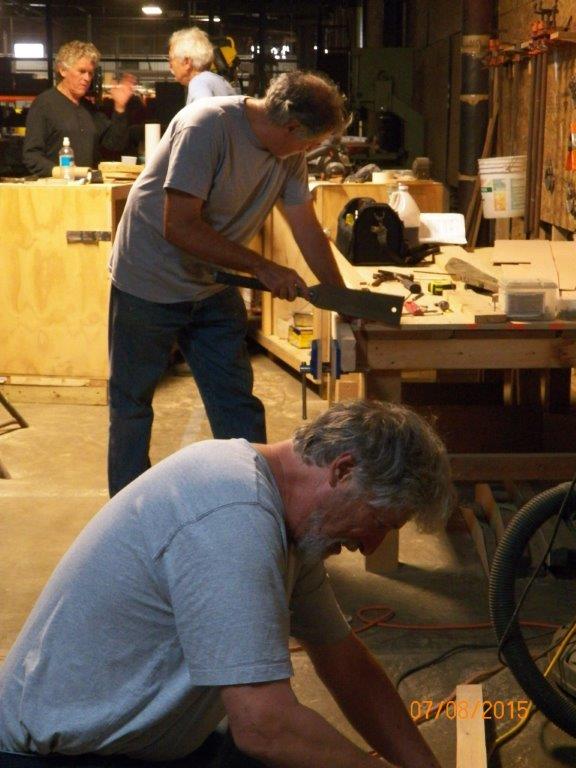 Hard at work/play at the reconstruction site last Thursday
Hard at work/play at the reconstruction site last Thursday
We teach interested persons how to sail while developing a relationship with the Hudson River by gaining an appreciation for the river’s history, an awareness of nature’s forces and the river’s environment while instilling a love for sailing. Pete Tenerowicz, member of HRHB took Kathy Hamm Parchuck of Hudson for a lesson this July.
President Louise Bliss writes:
Parchuck, after returning to shore took time to reflect on her sailing lesson
and experience. Just keeping your head, listening to and following directions
are some of the pieces of wisdom that Parchuck took to heart. Terms such as
apparent wind, tack, stays, jib, come about, hold your course, and main sheet
are now part of Parchuck’s vocabulary. Tenerowicz has been sailing since he
was a kid. His experience of over 30 years makes Tenerowicz a knowledgeable
teacher. Tenerowicz says that anyone can learn to sail if you have time and like
being on the water. Money and fame, Tenerowicz says are not part of the criteria
for learning how to sail.
Our Education Tent is a familiar and popular stop at many Hudson outdoor fairs and gatherings. This year we demonstrated steaming and shaping white oak into new mast hoops in our home-made steamer at the Mohawk Hudson Council of Yacht Clubs Boating Festival at Henry Hudson Park. Acquiring the skills to make our own mast hoops and the tools we needed to do it took much experimentation and rethinking and we are still learning and honing our techniques.
The Education Tent also is a place where young are introduced to the possibility that they too can become sailors and hopefully some of them will walk away with the desire to learn how to sail.
Call of the Running Tide
Monday, July 20, 2015
Mark Clarke, a friend and sometime sailor on the Eleanor, wrote about Captain Phil Egan
in this tribute published in the Register Star in August 1998.
Mark was an English teacher at Taconic Hills Central School District
and crewed on one of Eleanor’s OpSail adventures.
Recently, when we were in Washington D.C., my wife and I heard about Phil Egan’s passing. Although Phil was 95 years old and recently not enjoying the best of health, the news came painfully. Obituaries, however informative they may be, always seem inadequate when trying to form a complete picture of a person’s life. The leave so many holes. Like intricate puzzles, they always seem to be missing significant pieces.
I have known Phil for many years; he was a friend. He was the kind of person Charles Kuralt loved to seek out and interview for his television show, “On the Road.”
Phil had what we call in the Adirondacks “character.” Simply, he had a colorful personality, stood by his convictions, and possessed some peculiarity. For Phil, that peculiarity was his unusual passion for sailing.
Phil had a kind of love affair with sailing in which the poet John Masefield fervently writes in his poem entitled “Sea-fever.”
I must down to the sea again, for the call of the running tide
Is a wild call and a clear call that may not be denied;
And all I ask is a windy day with the white clouds flying,
And the flung spray and the blown spume, and the sea-gulls crying.”
At the beginning of this century, Phil’s love for sailing would lure him from the family farm in Columbia County and direct hit to the Maritime College in New York. As part of his naval training, he sailed to the Azores and back on a tall ship. it was quite an adventure as he told it. it was required of him to identify and name every part of the ship. (Several years ago, I was amazed when he recounted the name of every component of a tall ship from South America which was berthed in the port of Albany. He was late in his eighties!) Another part of his training was to climb up one side of the rigging and down the other. Hardly a simple task given the pitch and roll of a tall ship at sea. Grinning, Phillip admitted to me that he acquired a fondness for this activity.
But sailing came with its perils. On a more serious note, he recalled one cadet who fell from aloft and was killed. Because a land burial was not practical, the cadet was sewn in canvas, given a proper Christian service and the buried at sea. It was a reminder, Phil recounted, that the sea had her ways and that she was unforgiving for even the slightest error.
Upon his graduation it was necessary for him to return to the farm and manage the family’s affairs. Years would come and year would pass but he retained his youthful love for the sea.
Eventually, the passion became too much for him and he purchased the “Eleanor”, a wonderful old sailing sloop. She had a sleek wooden hull which sailed low in the water. As Phil told it, she had at one time been owned by the Livingston family. She had a lead keel which could be lowered beneath the hull to give it balance should the wind wish to lay her on her side. The mainsail was attached to wooden hoops which were manually hoisted to the top of the mast. An additional large triangular sail, the spinnaker, could be set on a long light pole at the bow of the ship to increase speed when “running before the wind.”
This is how I got to know Phil. I imagine that is how most people got to know him. He might start a conversation with, “Do you like to sail?” and then somewhere in the conversation extend an invitation to go sailing on The Eleanor. Phil’s friendships always seem to share the common denominator of sailing. One thing that was so unique about The Eleanor was that there was no auxiliary power. Translation: everywhere that The Eleanor sailed, she would have to advance under sail. This left little room for error. Very little.
Once when we were sailing up river (destination the Port of Albany) we happened upon a sudden squall. We quickly donned our oil skins (rain gear) and headed for the nearest marina. In order to make a safe an timely berth we would have had to “come about” 180 degrees and sail against the current and into the wind. The skipper let loose a blast from the fog horn, informing the marina of our impending berthing, then brought The Eleanor around and into the wind. Several people scrambled to the dock and yelled “Lower your sailed and come in under power.” He yelled back, “We have no power. We’re sailing her in.” The look on their faces was similar to what I expect classed across the faces of those who witnessed the 1937 Hindenburg Disaster. Undaunted, the skipper brought her in skillfully, against wind and tide, amid torrential down pour.
Sailing was not always a pleasant experience because it required simple living and we were always at the mercy of the elements. I can vividly remember sitting in mid-channel of the Hudson River just beyond the opening of the Catskill Creek: the cruel August sun beating down. Suffering, we waited patiently for a favorable change in the tide or hoped for an agreeable wind to come and fill our sails. When the elements worked against us, the skipper would suggest for someone to lightly scratch the mast with their nails while whistling a soothing tune. This, he explained, had the magic to say the forces of nature and bring favorable winds our way.
But when our sails were full and we cut a fine line in the water, it was truly a sight to behold. The Eleanor would majestically slice through the water; her mast tilted, the boom extended and the sails gorged with wind. Never was their [sic] such grace, neve was their such bliss.
Phil didn’t quite capture the image of the seasoned sailor. You know the kind, hardened men who use rough language. The kind of person you might find down a cobblestone street drinking in a sea-side tavern. A leather faced man with a patch drawn over one eye and a parrot perched on the opposite shoulder. Sitting alone [sic] with a cold pint tightly fisted in his hand, he would occasionally mumble something about having served with Lord Nelson at Trafalgar.
To the contrary, Phil was very different. He had gentle eyes and a wide warm smile. He never drank, swore and had a deep unshakable faith in God. Periodically he would take someone sailing up the Hudson River for a nominal fee, which he would then donate to charity. He had the curious habit of whistling without carrying any discernible tune. It must have been a generational peculiarity for I have found this unique only to my grandparents.
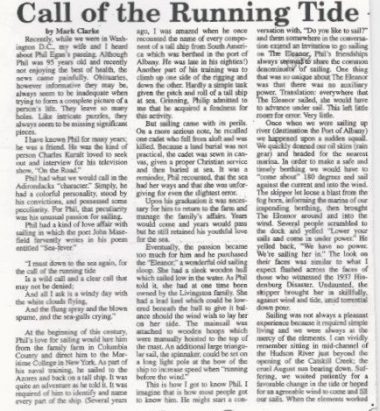 Phil was an anachronism. He held all of the characteristics of a 19th century sailor. That was a time when ships were made of wood and men were made of steel. Today, the ships are made of steel and the the men are made of wood. Phil held the oldest sailing license on the river. Phil was a steel of a man.
Phil was an anachronism. He held all of the characteristics of a 19th century sailor. That was a time when ships were made of wood and men were made of steel. Today, the ships are made of steel and the the men are made of wood. Phil held the oldest sailing license on the river. Phil was a steel of a man.
Bit the most remarkable aspect of Phil was not his love of sailing. No, it was far greater than that. His greatest attribute is that he never had a bad word about anyone and conversely, I never head anyone say a bad word about anyone and conversely, I never head anyone say a bad word about him. Imagine, living a lifetime and when it comes to a close, no one can find an unkind thing to say about you! That is remarkable.
Having just returned from Washington it has given me time to pause and reflect. Washington, known as the city of monuments, pays tribute to many great Americans: Washington, Jefferson, Lincoln. . . But I don’t suspect that there will be any monuments erected to the Phil Egans of the world too soon, and I’m sure that he wouldn’t want it any other way. Yes, as people, there is something here for us to learn. Phil’s passing reminds us of the wonderment and the preciousness of life. Anyone who knew Phil would agree that life wasn’t meant to be lived; on the contrary, it was meant to be celebrated.
The poet, Edgar Lee Master, wrote a poem entitled “Fiddler Jones.” It is about the reflection of a man on his past life.
I ended up with 40 acres, a broken fiddle,
a broken laugh, a thousand memories,
and not one regret.
Phil Egan reminded me of Fiddler Jones. He will be missed.
Operation Sail 1986 — excerpts from the Log
Monday, July 6, 2015
The following is based on a young Hudsonian’s entries in the Eleanor’s Log
on his first sailing adventure. One of the big goals of this restoration is to get Eleanor
back into the water so that she can provide young and old their first sailing experiences.
Sailing is more than just feeling the wind in your hair.
It is communication, understanding teamwork, building confidence,
experiencing something new and developing character.
These are the deeper and more lasting aspects of sailing.
Truly.
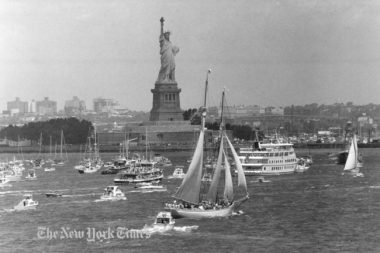 Saturday: I am not sure how I came to be on the crew for the trip to New York City for the Operation Sail Parade. Except maybe because my parents thought it would be a good experience for me, a fourteen year old boy, and they knew the Captain. I was promised an adventure. I had never been out sailing. I signed on to be crew with the promise from the Captain to my parents that he would look after me.
Saturday: I am not sure how I came to be on the crew for the trip to New York City for the Operation Sail Parade. Except maybe because my parents thought it would be a good experience for me, a fourteen year old boy, and they knew the Captain. I was promised an adventure. I had never been out sailing. I signed on to be crew with the promise from the Captain to my parents that he would look after me.
One week later, on June 28 at 1:20, just after four hours on the Eleanor, the tiller was in my hand.
“Steered Eleanor. Moved the tiller to the left to go right, and to the right to go left. Kept her on course as the Captain instructed.”
Good wind from the north. Sailed Eleanor past Hogs Back.”
As I passed the tiller to the next person, I felt pretty accomplished and satisfied. I felt good about being a member, a real member of the crew as we were called. Everybody took turns on the tiller and after that everybody had to write in the log book about their turn. Everybody took turns doing everything: cooking, sailing, navigating, main sheet, lookout, and resting. During rest time, I went up on the starboard side. I learned that is the right side facing forward and sat on the cabin deck and played the harmonica to entertain the crew. The captain liked that and he said it kept the wind coming.
“Took a place for sleeping on Eleanor.”
I took the cockpit floor. I had a mat and a sleeping bag. The other crew members had places – stern deck, cabin deck, bow, and the Captain slept down below on a bunk. It really wasn’t down below. You just had to get down low to go into the cabin.
“Slept very well under the stars with the gentle rocking of Eleanor. Up at 5:40 a.m. with change of tide.”
On board Eleanor I experienced everything from being becalmed to sailing in gale winds. On the day of the gale winds, I learned how to work as a team, and I mean TEAM with capital letters. The Captain had to give some orders which I learned had to be followed immediately if we wanted to survive. The wind came in gale force. I didn’t know what a gale force wind was, but it didn’t matter to me. This was terrifying. It was my turn on the main sheet which meant I was the person who would keep us from capsizing, but also keep us moving ahead which is very important for lots of reasons. Terror struck my heart. But, I felt and believed I could do this. I had learned the day before that we were all crew and someone would help me if I needed help. I had to slack the main sheet when the order was called, ‘slack the main sheet’, and ‘hold the main sheet’ when I had to instantly stop slacking the main sheet. Then I had to haul in on the main sheet when the order was called to haul in on the main sheet. To haul in on the main sheet I had to stand up and face the stern and haul in with all my might. Sometimes another crew member would have to help me because the wind was terrific and the sail was over 600 square feet. The waves were called rollers, and they were huge and we had to work our way through the troughs. The boat tipped or heeled over, the water came over the deck and the rail was under at times. This was an adventure . . a terrifying adventure. Once, the main sheet ran through my hands and burned them pretty badly. I learned not to let that happen. I learned about communicating on a boat and maybe even not only on a boat, maybe anytime. When an order is given, like ‘slack the main sheet’, the person giving the order may not have time to look around and see if the order has been carried out. So, a person responds, ‘slacking the main sheet’.. Or ‘let go the anchor’. ‘Letting go the anchor’ would be the response. That’s really important – to answer like that.
“Newburgh Yacht Club is a sailors dream. I am a sailor now.”
The yacht club is hard to get into by sail. Did I mention we do not have a motor? Anyway, after going aground at the narrow entrance to the yacht club (going aground is when everybody scrambles for poles from down below and pushes off) we tied up at the dock and everybody breathed a sigh of relief.
Newburgh has a restaurant, real toilets, and a swimming pool. As one of our men crew member called it . . . a stop with three s’s: shit, shower and shave. On the Eleanor we did have fresh water for ‘washing up’ with and for brushing our teeth, and we did have one of those boat toilets, but it wasn’t like the real thing.
“Captain treated me to a nice steak dinner. Great time in the pool.”
 Photo by Russ Cusick, Little Stoney Point Citizens Association
Photo by Russ Cusick, Little Stoney Point Citizens Association
Monday:
“Settling in to my adventure.
“Yours truly at the helm. Took the tiller while going around Little Stoney Point. Sailed past enthusiastic fan high up on the mountain side.”
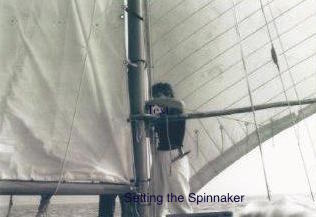 The Coast Guard charged passed us with their motors turned up to full speed causing white caps on the water. We were sailing with the wind and our spinnaker was up so as their wake hit us everything rocked and rolled high in the air. One of our crew strongly reprimanded the speeders.
The Coast Guard charged passed us with their motors turned up to full speed causing white caps on the water. We were sailing with the wind and our spinnaker was up so as their wake hit us everything rocked and rolled high in the air. One of our crew strongly reprimanded the speeders.
“Took us neatly around Constitution Island through Worlds End. River changes direction here. Changed tacks to get the wind and head on south past West Point.”
“Slept south of Tarrytown Bridge in the river. Threw lead line to figure how deep we were. Eleanor rocked a little bit. Stars bright and clear. Another great day of sailing.”
Tuesday:
Took tiller at 9:30 a.m. with a southerly wind. Vanquished three boats and gave the tiller over at the George Washington Bridge at 10:15 a.m. New York and the tall ships in the distance.”
